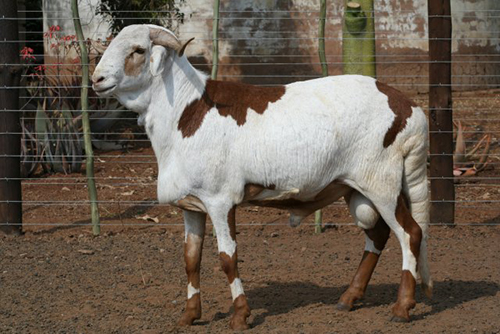DAMARA sheep are a unique breed of meat sheep. They have adapted to extreme climates and harsh environments across many countries such as Egypt, South Africa, Namibia, Sudan, Saudi Arabia and many other Middle Eastern countries.
They tolerate heat well, live and breed in harsh environments, under poor nutritional conditions and with restricted water. Damara are good food converters and can have a diverse diet made up of browsing material, shrubs and also make good use of low nutritional feed. This makes them ideal as scrub control livestock. Farmers can graze more sheep per hectare.
They don’t require shearing, crutching or docking they are very fertile and all-season breeders. Lambing percentages average from 110% to 130%. They have smooth clean rear ends unattractive to flies and a high resistance to most sheep diseases parasites.
Ewes can have their first lamb before they are one year old and generally have three lambs in two years. This breed of sheep requires minimal handling, maintenance and produce high quality meat sheep all year round.
Damara sheep originally came from North Africa the Middle East as early as 3000 BC.
They adapted to extremely harsh environments, little food and numerous predators.
Damara sheep have the ability to thrive in the most marginal conditions and have really proved their true value during the drought over the past few years.
The Damara’s fat tail is a distinguishing feature. It’s also a key to its robust nature and their ability to thrive in these harsh conditions. Damara sheep can raise a lamb on the fat reserves stored in the ewe’s tail.The tail acts like a camel’s hump storing fat. When they’re in good condition, the tails are fat and wide.
Damaras are able to survive without water for days at a time quite often lactating females only come in to water every three days.
They have a gut metabolism more like Brahman cattle, so they’ve got the ability to turn feed of less quality into meat and muscle.
Rams are left in with the ewes all year round some farmers have marked over 120% lambs in drought conditions.
There is no need for crutching or museling as their rear ends are smooth.
They are non-selective grazers, they browse grass, bush and shrubs and are excellent at weed management by rotational grazing reducing herbicide requirements.
Due to their strong flocking instincts they require less fencing than other breeds of sheep. They often graze and move within in sight of each other and rest as a group. This assists the ewes in defending their young from predators and makes moving the flock easy.
Damara lambs are born with ease and grow rapidly. Tails are not docked as this leads to abnormal fat deposits over the hindquarters. Twins are common.
Lambs can be weaned from 10 weeks, most producers achieving average target live weight of 35-36 kilogrammes within four to seven months.
Damara ewes are highly fertile with polyoestrous cycles, This means they are able to breed year round.
They are capable of lambs at months with their first lambing before 12 months of age. Generally ewes will produce three lambs in two years. They can cycle again as early as eight weeks after lambing.
Ewes have outstanding mothering instincts. If she has a lamb, rarely do you ever lose that lamb. They are extremely protective and defend their young.
Damara rams continue to breed over the age of 12 years old.
Damara first cross (F1) have Damara instincts and physical tendencies including the distinctive hide colourings on their body, legs, neck and head. They have a long nose and fat tail.
Stay informed with The Namibian – your source for credible journalism. Get in-depth reporting and opinions for
only N$85 a month. Invest in journalism, invest in democracy –
Subscribe Now!








